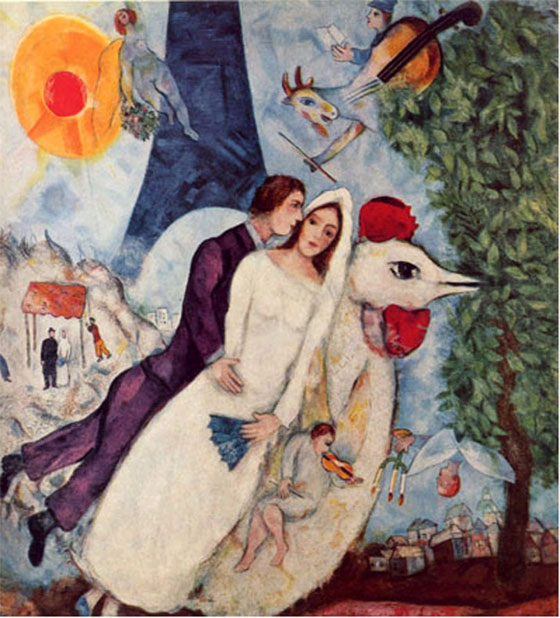
Marc Chagall, Les Fiancees de la Tour Eiffel
“A rock pile ceases to be a rock pile the moment a single man contemplates it, bearing within him the image of a cathedral.” Antoine de Saint-Exupéry once wrote in Flight To Arass. The book is a recollection of the days during Second World War when a handfull of French pilots continued fighting the Germans even as the fall of France was imminent, and speaks to the potency of hope imbued in imagination, metaphor, and spiritual life. The will to create and the soul are intimately linked.
This idea was discussed at some length last week on CBC’s “Tapestry”, a weekly radio program exploring what it means to be human with Canadian wildlife painter Robert Bateman, former nurse and musician Rosemary Phelan and Reverend Jennie Hogan. What do “art and soul” have to do with one another, asks host Mary Hynes? With the exception of Bateman each guest had had a fairly specific idea about what the relationship meant to them, though it was beyond the scope of the program to delve into the different roles and definitions people assign to both art and relation. In the same way that Christians describe each persons relationship with God as different, equally diverse, is the viewer’s relationship with art. We all need and want different things as we connect with the world.
“People expect something will change within them in the same way people expected church would do for them.” Reverend Hogan says of the Tate Modern in London, describing one rather uniform reaction to the transformed power station she labels a “temple for contemporary art”. Indeed she’s right — the grandeur of the Turbine Hall, the museum’s entrance embues any subsequent art viewing experience with residual awe — though I’ve never thought architecture that taps into our culture’s deep belief in industry and beauty should necessarily cement my own belief in art. Like faith, I don’t trust any relationship that isn’t also shaped by doubt. For better or worse, I swing between questioning art’s relevance and my own ability to evaluate it, and utter confidence in its ability to move me.
Interestingly, Hogan believes people have more faith in art’s transformative powers than they do religion. “People believe you have to have be some signed up person with absolutely rock solid faith in order to be part of the experience of going to a church or a cathedral,” she says, illuminating, perhaps, a rather large difference between the British viewing audience and Americans. While this may be changing, many Americans still avoid museums and especially galleries, because they believe they require specialized knowledge to participate. Of course, that’s not true, though the profession is insular enough that the discipline sometimes isn’t very interesting those outside it.
Assuming Americans will increasingly look to art to teach us about ourselves, what then, is role of the church? “I think we have to remember that there are clergy members all over the world who are burying people, baptizing people, marrying people, visiting the sick, feeding the homeless.” Hogan says, noting that it’s not particularly glamorous work. Of course, at this point, I’m sure there’s more than one artist out there who’s ordained themselves in the name of art. Like Hogan, who dedicates herself to God alone, so long as the artist makes the distinction between dedicating themselves to their practice, and not just the cause, the art world will accept the work as its own.
It’s worth mentioning that this distinction is mostly semantic as I don’t think the way we define artistic practice is so analogous to the worship of God that it warrants too much comparison, past the observation that both are seen as driving creative forces. The take home point, though, offered by Hogan, is that each will fuel the transformation of Saint-Exupéry’s rock pile. As such, maybe it’s not such a bad idea for the two to be working together.


Comments on this entry are closed.